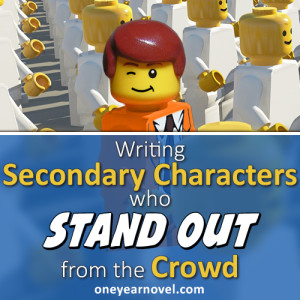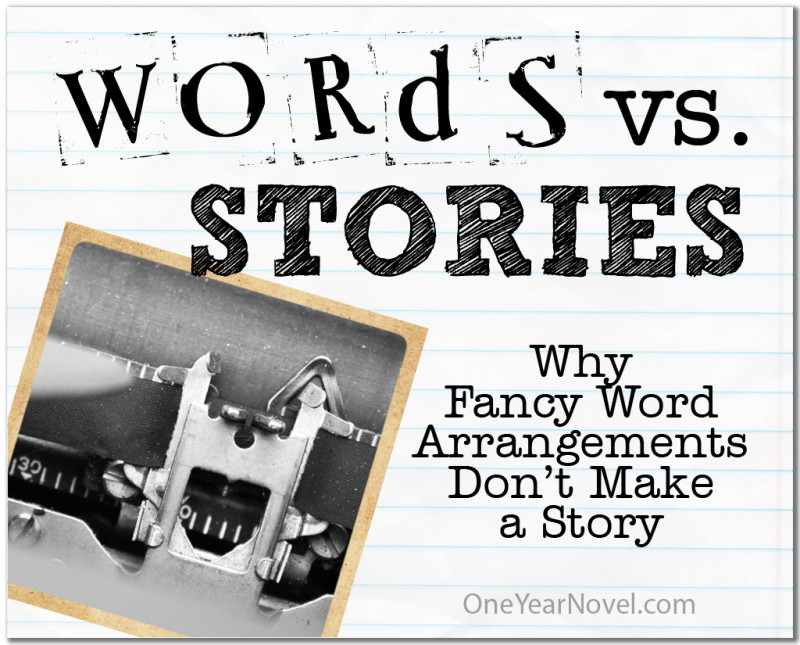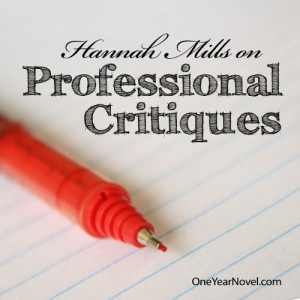Writing Secondary Characters Who Stand Out from the Crowd
By Emily Steadman, Guest Contributor
If somebody were to read my book and tell me she hated my heroine, I would eat my feelings via a tub of ice cream, and then have some serious rewriting to do. Most of us want our main characters to be likable. After all, the audience needs to connect with the heroine (or hero), sympathize with her, and read into the wee hours of the morning to find out what happens.
However, sometimes I shortchange my secondary characters because I’m focusing on my heroine. My thought process might go, “Let’s see, I need an emotional moment here… I know! I’ll have the ally pick a fight with her!” Why did he snap at her? Don’t know, don’t care; I got my emotional scene, and my audience probably feels bad for my poor, sweet heroine now; that’s all I need!
False.
It’s not that I’m against mean characters in novels; on the contrary, the “eviler” the better, if their actions create meaningful conflict. The problem is characters who are jerks just so we feel sorry for the main character: evil boarding school matrons who starve adorable children for no apparent reason, or bullies who spend every waking moment plotting ways to torment the heroine.
Not only is it cliché when I write like that, it’s unrealistic. It’s like I’m taking a megaphone and screaming in my reader’s ear, “LOOK AT MY HEROINE, DOESN’T SHE HAVE A HORRIBLE LIFE? YOU SHOULD LIKE HER.”
So how do we create sympathy for the main character without villainizing whoever comes against her? How do we create tension and conflict while treating characters on all sides as three-dimensional people who can be good as well as bad?
I humbly present three things that have helped me to create complicated secondary characters who aren’t unreasonable just for the sake of butting heads with my heroine.
1. Show the reader why your secondary characters are acting the way they are.
The heroine just had a horrible day at work. Fighting tears, she calls her ally to vent. The ally responds tersely. “Why are you always whining? Can’t you grow a backbone for once in your life? Get a grip.” Then he hangs up.
The heroine is left open-mouthed, and the audience thinks, “Wow, what a jerk.” They’re right; that was terrible. But as writers, we can’t make people randomly treat the heroine like trash whenever we need a sad scene. The ally loves the heroine; that’s why he’s the ally. He’d never speak that way normally. If we make him do that, something else must be going on. It’s our job as authors to figure out what.
Maybe he just had a fight with his parents. He and his family have never gotten along, but this time was serious. His dad just threw him out and told him to never come back. Now the ally is slouched in a dingy café trying to process. He has nowhere to go, but he knows the heroine needs to focus on the villain, and he doesn’t want to worry her. So when she calls him to complain, he’s irritated—her day was nothing compared to his, but he can’t tell her that. He’s also on the brink of crying, and the last thing he wants to do is break down in the middle of a café, especially with the heroine on the phone. So he yells at her, hangs up, and storms out. Later, he sinks down on a park bench, shivering in his thin jacket, and ugly-cries.
Now the audience knows exactly why he snapped at her. We feel bad for the heroine because she had a bad day that just got worse, but we also sympathize with the ally.
These scenes are easier to pull off with stories that use multiple points of view. When writing solely from the perspective of the heroine, it’s difficult to show the motivations of people who are rude to her. However, it’s not impossible to hint at sympathetic reasons. The heroine might become suspicious that something’s wrong with the ally. Alternatively, she could drive past the park and spot him slumped on the bench. Her hurt makes her bristle and keep driving, but the reader is now wondering what he’s doing at the park by himself in the cold, and hopefully begins to realize that something deeper is going on.
However we do it, giving reasons or implied reasons for our characters’ actions is a fantastic way to give them depth. No character is ever a jerk for no reason. The villain is not embezzling money from sweet, elderly grandmothers for the heck of it. There’s a story behind how he became such a twisted person. His problems don’t excuse him for being a jerk, but they help us understand him.
2. Make sure the heroine isn’t always right in an argument.
Sometimes, the heroine’s going to make stupid decisions—not because she’s an idiot, but because she hasn’t eaten in twelve hours or because her beloved dog just died. The allies don’t always have to follow her lead. They shouldn’t be mindless drones who hang on the heroine’s every word; they’re people. If she’s about to make a bad move, even if her motives are understandable, the allies should tell her she’s being ridiculous. The audience can sympathize with the heroine because her dog just died, but agree with the allies when they point out that she shouldn’t charge into the Dark Dungeon of Stabby Booby Traps unarmed. The allies are making things harder on her, but we understand why—they’re doing it out of concern.
3. Craft dilemmas where there is no “right answer”.
Mr. S. talks about creating dilemmas that force the hero to make terrible choices. These are great places for our characters to disagree. Sometimes, they have to either save the burning Cute-Orphan-Ville while the villain massacres the heroine’s hometown, or chase the villain and let Cute-Orphan-Ville burn. There’s no right answer there; people will die no matter what. So if the heroine decides to rush off to protect her hometown, it’s likely that one of the allies will say, “Um, hello, we can’t just leave these orphans to die!” Neither one is being evil; their emotions are just sending them different messages.
Each character in our novels has a backstory and a complicated personality, not just the heroine. They all have motivations, fears, and things they hold dear. These will make each one react differently in a given situation. That doesn’t make anyone’s reaction necessarily “wrong” or “right”—it just makes the characters complicated, emotional people who don’t always agree with each other.
Our heroines (or heroes) are the main characters of the book. But our villains, allies, and background characters are all the main characters of their own lives. We’re not just telling the story of our heroines. We’re telling all of their stories, weaving each one’s tale into the overall narrative while artfully keeping the story of the heroine at the forefront. We must treat each character—from the most dastardly of villains to the sweetest of allies—with the dignity and complexity they deserve, and not make them irredeemable jerks who are mean just because it works for the scene.
Once we do that, we’re one step closer to making our novels good.
…
Who are some of your favorite secondary characters in literature? What traits make them your favorites?
…
Emily is a six-time novelist and has been a student of the One Year Adventure Novel program since 2011. She received semi-finalist in the 2013 Student Novel Contest, and has been a critique group leader at multiple Summer Workshops. Her favorite things include good friends, drawing, and anything to do with writing. A passionate “OYANer,” she loves her writing community and thrives on critiquing and chatting with her fellow students. She is currently in the honors program at her university with an animation major and a film minor.





This is great! Thank you so much, Emily! 😀
I’m still growing in this area, and this really helps. 🙂
My main problem with character making tends to be they lean towards being borring / serious. I’m told I should have a funny character in my story, but I don’t know how to write one… Yet. 🙁
Any tips?
(Sorry for how long it took to get back to you! <3) Not a problem at all! I'm so glad that it helped you; praise God. 😀
To be honest, while I've been told before that I have one or two characters who are funny, I really don't know how to make them funny. However, I found this blog post that has some good tips; hopefully it's helpful!
http://allindiewriters.com/make-your-writing-funny-creating-humorous-fictional-characters/
Best of luck! 😀
(You’re fine. 😉 )
Great! I’ll look into that! 😀
Thanks a lot! 🙂
Not a problem! <3
Don’t worry about putting humor in your story. Go looking for it. The funniest stuff in life usually just happens, especially along the lines of What Could Go Wrong. The difference is that instead of instilling a sense of dread, it ends up being more of a “I can’t believe I just did that/that just happened” type of situation.
Thanks, Caleb! 😀 I’ll keep my eye out.
I actually have an example of that in a story idea I have.
The main character is in a life threatening situation on a motorcycle, when she tries to swipe the back of her hand across her forehead, only to crack it against her helmet. 😀 It was humorous for the moment and briefly added tension to the situation. 🙂
*SCREAMS* EMILY, THIS WAS AMAZING. I’M SO PROUD OF YOU. *thunderous applause*
Also I loved how you incorporated Mr. S’s humor (Dark Dungeon of Stabby Booby Traps, anyone? I was laughing through that. XD) and how your examples dovetailed with lessons in “The Compass.” 🙂
And you broke my heart with the Ally’s woeful backstory!!! (Ah, I love him…) I want to hear his story now! XD
Wonderful insights! I need more! 😀 *hugs* <3 😀
You are so sweet to me, Anna! Thank you for your encouragement. <3
*SCREAMS* EMILY, THIS WAS AMAZING. I’M SO PROUD OF YOU. *Thunderous applause.*
Also I loved how you incorporated Mr. S’s humor (Dark Dungeon of Stabby Bobby Traps, anyone? I was laughing through that. XD) and how your examples dovetails with lessons in “The Compass.” 🙂
Ahhh, you broke my heart with the Ally’s tragic backstory!! What happens to him?! I want his story now! XD
WONDERFUL insights! I need more!! *hugs* <3 😀